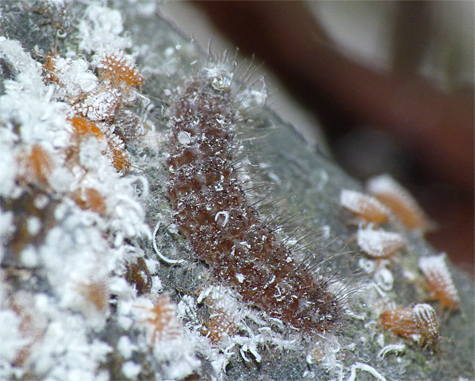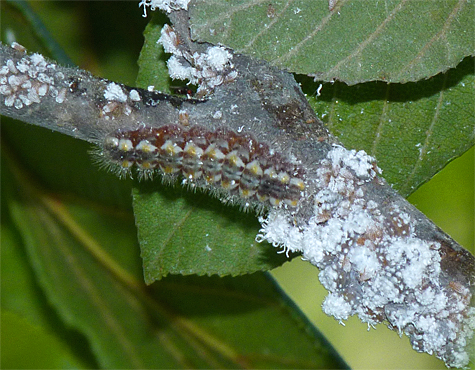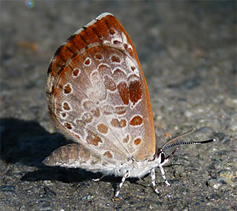
The caterpillar in the above photo was about 5 – 6 mm in length when the photo was taken. Those are aphids, in various stages of developement, on either side of the caterpillar. Ever since spotting the woolly aphids on an alder on the north side of the Wetlands I’ve been watching for harvester caterpillars to appear. They’re here.

Last year I spied the first harvester caterpillars, the only North American carnivorous caterpillars, on the alder during the first week on September. I did not see a butterfly last year until after the caterpillars matured, pupated and emerged as adults. I have yet to see a butterfly this year.
I spend a fair amount of time walking around the outdoor loop at the Museum. Every time I walk past the alder on which the aphids reside I look at the colony and see all sorts of ants, bees and wasps, lady beetles, other insects, and even other butterflies buzzing, hovering, or walking around or on the alder.
The collection of insects mentioned above are all attracted to the alder and its colony of aphids for various reasons. They’re there to directly lap up the honeydew produced by the aphids, suck up the drippings on the leaves and branches below the aphids, or in the case of the lady beetles, to eat the aphids. But, I say again, so far this year I have not seen a harvester butterfly.

Do harvesters only lay their eggs in the early morning or late afternoon when I, or anyone else, is not here to see them? I don’t know. The butterflies don’t visit flowers for nectar so it’s not likely you’ll find one in a garden. They do sip mud for nutrients and suck up honeydew from the aphids that its caterpillar eats. One would think that the adult butterflies would be easy to spot in the vicinity of the aphids, both mud and honeydew are readily available to the butterflies.
While a mystery to me why I haven’t seen an adult butterfly, I plan to keep an eye out for them just the same. I suppose, though, I can wait until the caterpillars that are now feeding on the aphids form chrysalids, pupate and emerge as butterflies. That is, of course, assuming I can locate the chrysalids and am standing in front of one of them when the butterflies emerge. It’s a risky business, this naturalizing, but I’m up to it.